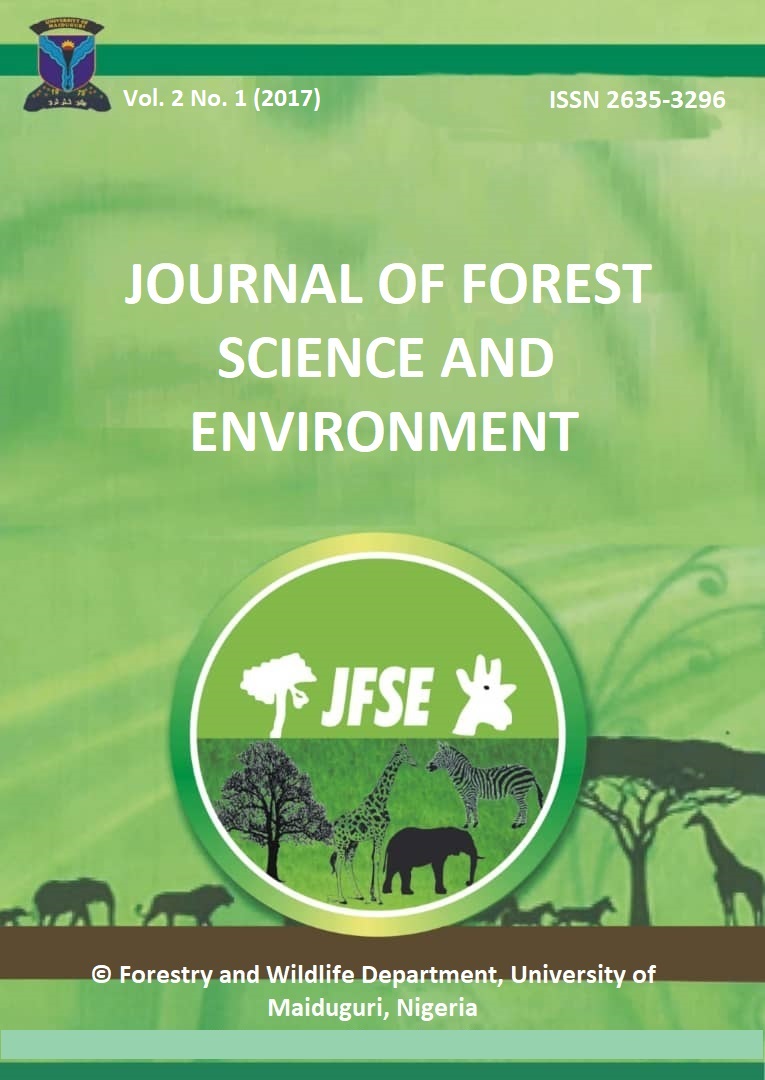Abstract
The research was conducted to assess the diversity of wild fruit trees in floodplains of Adamawa State, Nigeria. Three floodplains in Adamawa State (Demsa, Song and Mubi South Local Government Areas) were selected for the study. One hectare sample plots were marked out in each of the floodplains and all matured wild fruit trees within the plots were identified, counted and their girths at breast height measured. Abundance, frequency, relative frequency, density, relative density, dominance, relative dominance and important value index were determined using relevant formulae. Simpson’s Diversity Index was used in determining the species diversity in each of the plots. Comparison of the diversity index of Demsa and Song study sites using t-test at 0.05% level of probability showed no significant difference. The same was for Song and Mubi; Mubi and Demsa respectively. Results showed that twelve species of trees belonging to ten families were identified in the floodplains. The species diversity indices of the three sites were 0.2319, 0.2310 and 0.1549 for Demsa, Song and Mubi South respectively indicating that the floodplains had high diversity of wild fruit trees.
References
Adebayo AA (1999). Adamawa State in Maps. Paraclete Publishers, Yola.
Awodoyin RO, Olubode OS, Ogbu JU, Balogun RB, Nwawuisi JU and Orji KO. (2015): Indigenous Fruit Trees of Tropical Africa: Status, Opportunity for Development and Biodiversity Management. http://www.SODB.org/journal/ashttp://dx.doi.org/10. 4236/as.2015.61004
Goldsmith FB, Harrison CM and Morton AJ (1986). Description and analysis of vegetation. In: Moore PD and Chapman SB (eds.) Methods in plant ecology. Blackwell Scientific Publications, Oxford, England. Pp 437-524
Mahapatra AK, Satarupa M, Uday CB and Protap CP (2012). Nutrient analysis of some selected wild Edible fruits of deciduous forests of India: An Exploration study toward Non convention Bio-Nutrition. Advance journal of Food Science and Technology 4(1); 15-21.
Makurji AK (2005). Importance of Non-Wood Forest Products (NWFPs) and strategies for sustainable development. Forest and Environment; Consulting engineering sevices, India.
National Academy of Scicence (2008). Lost crops of Africa: Vol. 3. Fruits. National Academies Press. Washington D.C. 381p. http://www.nap.edu/catalog/11879, html
National Bureau for Statistics (2007). Federal Republic of Nigeria 2006 Population Census Official Gazette (FGN 71/52007/2, 500 (OL24). Legal Notice of Publication of Details of Breakdown of National and State Provisional Totals 2006 Census. www.nigeriastat.ng pp 10
Nazarudeen A (2010). Nutritional Composition of Some Lesser-known fruits used by the ethnic communities and local folk of Karala. Indian Journal of Traditional Knowledge.Vol. 9(2), pp 398-402
Ojanuga AG (2006). Agroecological zones of Nigeria. Manual. In:Berding F. & Chude, V. O. (eds.) National Special Programme for Food Security (NSPFS) and FAO, 124.
Pye-Smith C (2010). The Fruits of Success: A programme to domesticate West and Central Africa’s Wild Fruit Trees in raising incomes, improving health and stimulating the rural economy. ICRAF Trees for Change No. 4. Nairobi: World Agroforestry Centre Pp 32.
Usher MB (1992). Quantitative Aspects of Collection and Analysis of Inventory Data Conservation Biology: A Training Manual for Biological Diversity and Genetic Resources. P. Kapoor-vijay and J. White (eds). Commonwealth Secretariate, 1992 Pp73-77

